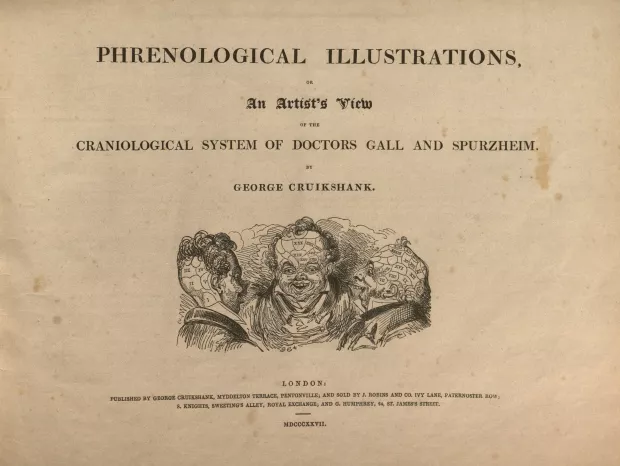Creation Date
1 August 1826
Height
26 cm
Width
37 cm
Medium
Genre
Description
The mapped head was associated with phrenology from its earliest publications throughout the nineteenth century. It provided a useful map of the locations on the skull discussed in phrenological tracts. One contemporary reviewer explained, “The author’s mode of treating the subject is illustrated, and rendered very intelligible, by a plate of the human head having the organs delineated” (“The Phrenological System"). By illustrating the “scientific” mapping of phrenologists, this particular image reveals the association between disfigurement and character as it was used by both phrenologists and caricaturists (Stafford 344).
Three men face each other, with the central figure looking toward the viewer. Each man is distinguished by his exaggerated expression, unusual head shape, and the phrenological map that has been drawn onto his head. Though the mapped head is a common phrenological illustration, this image is unusual in that its mapped heads appear to be alive and interacting with one another.
The first of Cruikshank's "punning monographs," Phrenological Illustrations made use of the public's growing interest in scrapbooks or miscellanies to pun on the pseudo-science of phrenology as it grew in popularity (Patten, George Cruikshank's Life 259, 286f). Contemporary periodicals identified Phrenological Illustrations for its contributions "to the celebrity of [Deville’s and Spurzheim's] science," claiming that Cruikshank's work popularized phrenology even more than the phrenologists' lectures ("Phrenological Illustrations" 60). By illustrating the "'primitive' or 'natural' inclination of man" as explained by phrenologists, Cruikshank's work reveals the association between disfigurement and character as it was used by both phrenologists and caricaturists (Stafford 344). Finally, Cruikshank’s Phrenological Illustrations also participates in a larger tradition of phrenological parody by both poking fun at the pseudo-science's claim to an infallible "reading" of the subject and by revealing the extent of its popularity.
Social caricature satirized popular trends not simply in order to entertain but also to inform or alter public opinion. Caricatures of phrenology taught the “clinical gaze” by illustrating the pseudo-science’s usefulness (or lack thereof) in the interpretation of human appearance and—because the exterior or visible was here equated with the interior or unknown—in the reading of human character ( Foucault 103ff).
Associated Works
Copyright
Copyright 2009, Department of Special Collections, Memorial Library, University of Wisconsin-Madison, Madison, WI
Collection
Accession Number
+ 972135
Additional Information
Bibliography
Cowling, Mary. The Artist as Anthropologist: The Representation of Type and Character in Victorian Art. Cambridge: Cambridge UP, 1989. Print.
Cruikshank, George. Phrenological Illustrations. London: George Cruikshank, 1826. Print.
Douglas, Richard John Hardy. The Works of George Cruikshank Classified and Arranged. London: J. Davy & Sons, 1903. Print.
Foucault, Michel. The Birth of the Clinic. Trans. Alan Sheridan. New York: Routledge, 2003. Print.
Karp, Diane. "Madness, Mania, Melancholy: The Artist as Observer." Philadelphia Museum of Art Bulletin 80.342 (1984): 1-24. Print.
McLaren, Angus. "Phrenology: Medium and Message." The Journal of Modern History 46.1 (1974): 86-97. Print.
Patten, Robert. "Conventions of Georgian Caricature." Art Journal 43.4 (1983): 331-8. Print.
---. George Cruikshank's Life, Times, and Art: 1792-1835. Vol. 1. Rutgers UP, 1992. Print.
"Phrenological Illustrations by Mr. George Cruikshank." National Magazine, and General Review Nov. 1826: 60. Print.
The Phrenological Journal and Miscellany Vol. 3. (August, 1825 – October, 1826): Edinburgh, 1826. Print.
“The Phrenological System.” The Bristol Mercury 1697 (September 30, 1822). Print.
Spurzheim, Johann Kaspar. Phrenology, or, The Doctrine of the Mind. 3rd ed. London: Charles Knight, 1825. Print.
Stafford, Barbara Maria. Body Criticism: Imagining the Unseen in Enlightenment Art and Medicine. Cambridge, MA: MIT Press, 1991. Print.
Stafford, Barbara Maria. "From 'Brilliant Ideas' to 'Fitful Thoughts': Conjecturing the Unseen in Late Eighteenth-Century Art." Zeitschrift fur Kunstgeschichte 48.3 (1985): 329-63. Print.

